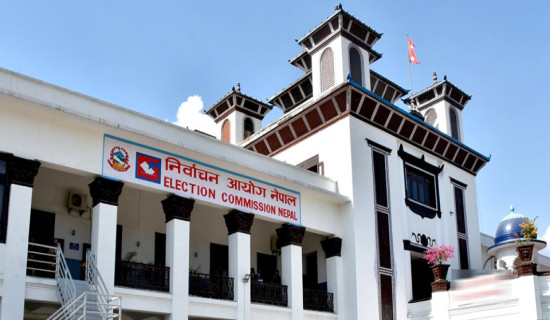- Monday, 19 January 2026
Candidates Must Focus On Poverty Reduction
Nepal faces a myriad of challenges in all walks of life. Who would know this better than the lower rungs of the Nepali society, the lesser mortals that constitute a silent majority? A majority of mouths but with a barely audible voice in matters that affect them the most. They are seldom heard during such rare occasions as election campaigns. Even if they are heard, they are quickly forgotten -- till the next elections.
Poverty, which comes in almost every imaginable form and shape, is one such challenge facing the country in general and the bottom rung in particular. A recent report has highlighted this challenge, once again. 'Nepal Multidimensional Poverty Index 2021: Report (Analysis Towards Action)' points that in 2019, 17.4 per cent of Nepalis were multidimensionally poor – just under five million persons, and the Multidimensional Poverty Index (MPI) was 0.074. First, a little bit about the MPI. For one thing, MPI is not just one fancy development jargon. The report defines MPI as a technically rigorous measure of poverty of national and provincial policy priorities towards poverty reduction in Nepal.
Across indicators, as per the report, the highest number of people was deprived of housing materials, clean cooking fuel, years of schooling, assets, and nutrition. Considering the indicator weights, years of schooling and nutritional deprivations contributed most to ongoing multidimensional poverty in Nepal. The urban-rural divide also figures in the report, with the rural lot on the receiving end. According to the report, 28 per cent of rural dwellers are MPI poor compared to 12.3 per cent in urban areas. What’s more, over half of Nepal’s poor population live in rural areas.
Worrisome picture
Province-wise, the report paints a worrisome picture of the peripheries, while all seems to be well with the centre and the semi-peripheries. Across provinces, Karnali Province had the highest MPI poor (39.5 per cent of people), followed by 25.3 per cent in Sudurpashchim Province, and 24.2 per cent in Province 2. In Gandaki Province, 9.6 per cent of people were multidimensionally poor, while the lowest level and incidence of poverty were found in Bagmati Province, with an incidence of nearly 7.0 per cent, one-sixth of the incidence in Karnali Province. Alarmingly, children still remained the poorest age group with over one in five children still poor (2.2 million). The report has disaggregated children in two age groups: children (0-17) and adult population (18+).
In Nepal, children represent nearly 35 per cent of the population from 44 per cent of those who are poor. And 21.8 per cent of all children were living in multidimensional poverty as compared to 15.1 per cent of the adult population. This age category was further broken down into two categories: early childhood (aged 0-9 years) and adolescence (aged 10-17 years). Of the households living with a child 10 years, the MPI for these households was 0.124 with an incidence of poverty of 27.8 per cent, and an intensity of 44.5 per cent. By contrast, the MPI for households living with an adolescent was 0.064, with an incidence of poverty of 14.9 per cent, and an intensity of 43.0 per cent.
Gender-wise, the female population is faring worse in terms of poverty than the male population. The report stated that the incidence of multidimensional poverty amongst the male population (comprising 47.3 per cent of the total population) stood at 14.3 per cent and 15.1 per cent for female population (comprising 52.7 per cent of the total population).
The report has also drawn attention towards MPI in families where one of its members has a disability (someone who reported very high level of difficulty in at least one domain: visual; hearing, walking, or climbing steps; remembering or concentrating; self-care, or in communication). As per the report, nearly 3.2 per cent of the population lived in a household where one of its members had a disability. The report found MPI for these households to be a bit higher than the national average, at 0.083, with an incidence of poverty of 18.3 per cent, and an intensity of 45.5 per cent.
Significant progress
The report points that Nepal has made significant progress in reducing MPI. In terms of poverty trends, the incidence of multidimensional poverty nationally fell from 30.1 per cent in 2014 to 17.4 per cent in 2019. In 2019, the MPI was 0.074, meaning that 3.1 million people left poverty in five years. The intensity of multidimensional poverty also significantly decreased from 44.2 per cent to 42.5 per cent. Nepal’s 2019 MPI value of 0.074 was below Bangladesh’s 2019 MPI of 0.104 and was lower than the MPI values for all South Asian countries except the Maldives.
But deeper troubles are not that far for ill-prepared countries like Nepal. The poverty scenario is likely to worsen further, amid rising inflation resulting from the Russia-Ukraine war in one of the world’s major oil and natural gas-producing regions that also happens to be a huge grain basket. Reports also point that the global economic depression is around the corner, with the war hastening it further.
For Nepal, the immediate casualty may be the 15th Development Plan’s goal of reducing MPI to 11.5 per cent from 28.6 per cent.
In such a crisis situation, Nepal’s political leadership cannot and shall not remain complacent. The onus is also on the people themselves to read election manifestos of different political actors and ask them some tough questions related to the country in general and the national economy in particular as they come asking for votes to reach power in the centre and in the provinces. And after voting these actors to power, the people should see to it that they walk the talk. As someone rightly said, eternal vigilance is the price of democracy.
(Gautam is a freelancer.)












-original-thumb.jpg)




